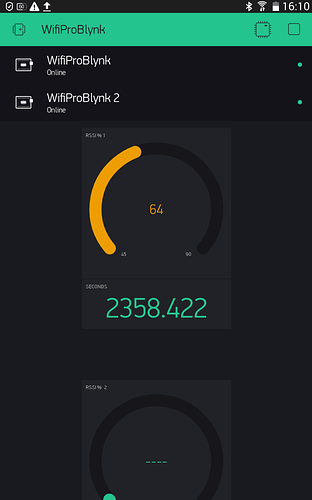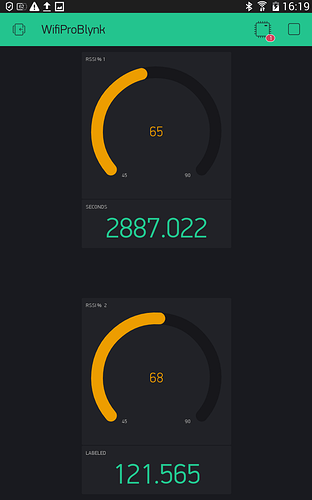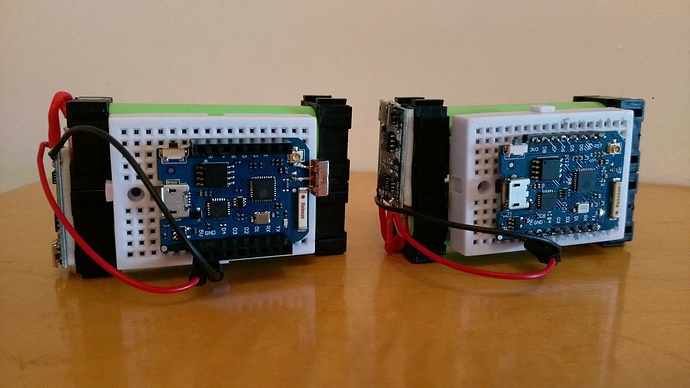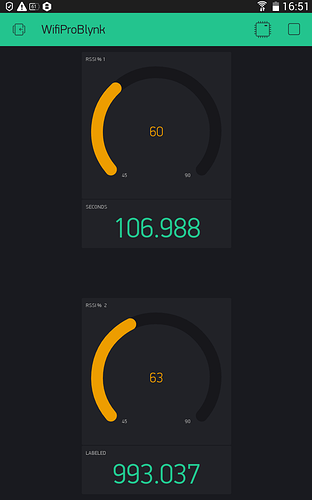Not so much a project but more a quick review of the “Pro”.
This is the code that goes with the video above (excluding the “kitten”) that I was asked to post to show the signal strength of the WeMos D1 Mini Pro with an external aerial connected.
// WiFiPro.ino Project name WiFiPro4Blynk by Costas 18th Sept 2016
#define BLYNK_PRINT Serial // Comment this out to disable prints and save space
#include <ArduinoOTA.h> // for local OTA updates
#include <ESP8266WiFi.h>
#include <BlynkSimpleEsp8266.h>
#include <SimpleTimer.h> // Essential for almost all sketches
SimpleTimer timer;
//********************* SECTION FOR YOU TO COMPLETE WITH YOUR DETAILS *************
// Get Auth Token in the Blynk App.
char auth[] = "xxxx"; // Go to the Project Settings (nut icon).
char cloudserver[16] = "blynk-cloud.com";
char localserver[16] = "192.168.10.229"; // Enter your IP details for the local server
char ssid[] = "GargoyleTest"; // Your WiFi credentials.
char pass[] = "xxxx"; // Set password to "" for open networks.
char OTAhost[] = "WiFiPro4Blynk"; // Optional, but very useful
//************************************************************************************************
// pick colours from http://www.w3schools.com/colors/colors_picker.asp
#define BLYNK_RED "#D3435C" // used when RSSI is worse than -83 dBm (< 60%)
#define BLYNK_YELLOW "#ED9D00" // used when RSSI is between -83 dBm and -57 dBm (60% to 75%)
#define BLYNK_GREEN "#23C48E" // used when RSSI is better than -57 dBm (> 75%)
/* other colors, not used
#define BLYNK_BLUE "#04C0F8"
#define BLYNK_DARK_BLUE "#5F7CD8"
#define BLYNK_BLACK "#000000"
#define BLYNK_WHITE "#FFFFFF"
#define BLYNK_MAROON "#A12345"
#define BLYNK_PINK "#FFB3B3"
#define BLYNK_OLIVE "#808000" */
void reconnectBlynk() { // reconnect to server if disconnected, timer checks every 60 seconds
if (!Blynk.connected()) {
if(Blynk.connect()) {
BLYNK_LOG("Reconnected");
} else {
BLYNK_LOG("Not reconnected");
}
}
}
void setup()
{
Serial.begin(115200);
Serial.println("\n Starting");
//Blynk.begin(auth, ssid, pass); // normal Blynk Cloud server connection
//Blynk.config(auth, cloudserver); // for Blynk's cloud server if WiFi already connected
Blynk.begin(auth, ssid, pass, localserver); // for a local server requiring WiFi connection
int mytimeout = millis() / 1000;
while (Blynk.connect(1000) == false) { // wait here until connected to the server
if((millis() / 1000) > mytimeout + 8){ // try to connect to the server for less than 9 seconds
break; // continue with the sketch regardless of connection to the server
}
}
Serial.println(map(WiFi.RSSI(), -110, -30, 45, 90) + String('%')); // only display on bootup
ArduinoOTA.setHostname(OTAhost); // for local OTA updates
ArduinoOTA.begin(); // for local OTA updates
timer.setInterval(15000, reconnectBlynk); // check every 15 seconds if we are connected to the server
timer.setInterval(300, showRSSI); // was 600
}
void showRSSI(){
//Serial.println(map(WiFi.RSSI(), -110, -30, 30, 100) + String('%'));
if(WiFi.RSSI() < -83){
Blynk.setProperty(V0, "color", BLYNK_RED); // red gauge
}
else if(WiFi.RSSI() > -57){
Blynk.setProperty(V0, "color", BLYNK_GREEN); // green gauge
}
else{
Blynk.setProperty(V0, "color", BLYNK_YELLOW); // yellow gauge
}
delay(30);
Blynk.virtualWrite(V0, map(WiFi.RSSI(), -110, -30, 45, 90));
float cycle = millis() / (1000.0);
Blynk.virtualWrite(V1, cycle);
}
void loop()
{
if (Blynk.connected()) { // to ensure that Blynk.run() function is only called if we are still connected to the server
Blynk.run();
}
timer.run();
ArduinoOTA.handle(); // for local OTA updates
}
Review of the ceramic V external antenna at http://forum.wemos.cc/topic/702/mini-pro-wifi-testing. As with our work with the ESP07’s the ceramic aerials don’t generally appear to be any better than the onboard antenna’s of an ESP01/12 but an external aerial certainly improves things. An external antenna is even more important once you have put your ESP in a sealed case.
It might be partly because the “RSSI” sketch is very short compared with our real projects but the upload times with the new serial chip on the Pro are lightening fast and reliable. Previously with the regular Mini 921600 baud was quite hit and miss but no so with the Pro.
The Pro’s are noticeably lighter than the Mini’s so might be useful if you are using them in a drone. They are also single sided, so now lay flat on a circuit board unlike the regular Mini’s.
All in all a big improvement over the standard Mini and that is before taking into account the flash size increase from 4MB (16M) to 16MB (128M).







